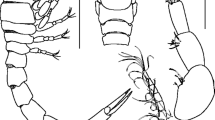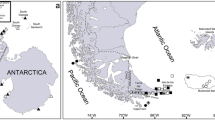Abstract
An examination of a syntype of Cuspidaria cochinensis Preston, 1916, focusing on the characters of the hinge, supports the transfer of this species to the family Corbulidae. Recently collected material from the Cochin Backwater is used to describe the shell and anatomy of the adult form. The ctenidia are composed of two demibranchs, both flat and homorhabdic, this further confirming that this species is eulamellibranch and not septibranch. The most appropriate generic placing of this species is in Cuneocorbula; thus, it is the first recorded extant species of the genus.




Similar content being viewed by others
References
Anderson LC, Roopnarine PD (2003) Evolution and phylogenetic relationships of Neogene Corbulidae (Bivalvia; Myoidea) of tropical America. J Paleontol 77(6):1086–1102
Annandale N, Kemp S (1916) Fauna of the Chilka Lake. Mollusca Gastropoda and Lamellibranchiata. With an account of the anatomy of the common Solen by E. Ghosh. Memoirs of the Indian Museum 5:328–374, pls 14–16
Coan EV (2002) The eastern Pacific recent species of the Corbulidae (Bivalvia). Malacologia 44:47–105
Cossmann M (1886) Catalogue illustré des coquilles fossiles de l’Eocène des environs de Paris. Ann Soc Roy Malac Belgique 21:1–46
Deshayes G-P (1860) Description des animaux sans vertèbres découverts dans le bassin de Paris pour servir de supplément à la description des coquilles fossiles des environs de Paris comprenant une revue générale de toutes les espèces actuellement connues. Tome Premier-Texte. Mollusques acéphalés dimyaires accompayné d’un Atlas de 89 plances. Paris, J-B Baillière et Fils, Libraires de l-académie impériale de Médecine, 912 pp
Hallan A, Colgan DJ, Anderson LC, García A, Chivas AR (2013) A single origin for the limnetic–euryhaline taxa in the Corbulidae (Bivalvia). Zool Scr 42(3):278–287
Huber M (2010) Compendium of bivalves. Conchbooks, Hackenheim, 901 pp + CD
Keen M (1969) Myacea, pp N690–N699. In: Newell RD (ed) Treatise on invertebrate paleontology. Part N. Mollusca 6: Bivalvia, Vol. 2. Geological Society of America, Boulder, Colorado, pp N491–N952
Mienis HK (2012) Arthur Blok (1882–1974), his shell collection and library. Haasiana 6:41–55
Preston HB (1907) XXVII.—Diagnoses of new species of Corbula and Bithinella from Lower Bengal. J Nat Hist 19(ser.7):215–216
Preston HB (1911) Description of six new species of shells from Bengal and Madras. Rec Indian Mus 6:39–42
Preston HB (1916) Report on a collection of Mollusca from the Cochin and Ennur backwaters. Rec Indian Mus 12(1):27–39
Subba Rao NV, Surya Rao KV, Maitra S (1991) Marine molluscs. In: Zoological survey of India: State Fauna Series 1: Fauna of Orissa (Part 3):1–175
Yonge CM (1946) On the habits and adaptations of Aloidis (Corbula) gibba. J Mar Biol Assoc UK 26:358–376
Hallan A, Willan RC (2010) Two new species of Lentidium (Myida: Corbulidae) from tropical northern Australia: remarkable fresh/fluviatile to brackish-water bivalves. Molluscan Res 30(3): 143-153.
Acknowledgements
The samples were taken as part of the research project entitled “Ecology and fish production potential of the Kodungallur-Azhikode back water ecosystem” funded by the Kerala State for Council Science, Technology & Environment (KSCSTE), and Jayachandran PR and S Bijoy Nandan are thankful for their financial assistance. The authors are also thankful to the National Museum of Wales, United Kingdom and Department of Marine Biology, Microbiology and Biochemistry, Cochin University of Science & Technology for providing the necessary facilities. PG Oliver is grateful for electronic access to the library of the University of Bangor, Wales and to Laurie Anderson (South Dakota School of Mines and Technology), Anders Hallan (Australian Museum, Sydney), John Taylor (Natural History Museum, London) and Henk Dekker (Naturalis Biodiversity Center, Leiden) for the useful discussions on possible generic placements.
Author information
Authors and Affiliations
Corresponding author
Additional information
Communicated by V. Urgorri
Rights and permissions
About this article
Cite this article
Oliver, P.G., Jayachandran, P.R. & Nandan, S.B. Cuspidaria cochinensis Preston, 1916 transferred to the Corbulidae (Mollusca, Bivalvia) and assigned to the genus Cuneocorbula . Mar Biodiv 48, 1223–1227 (2018). https://doi.org/10.1007/s12526-016-0578-y
Received:
Revised:
Accepted:
Published:
Issue Date:
DOI: https://doi.org/10.1007/s12526-016-0578-y




